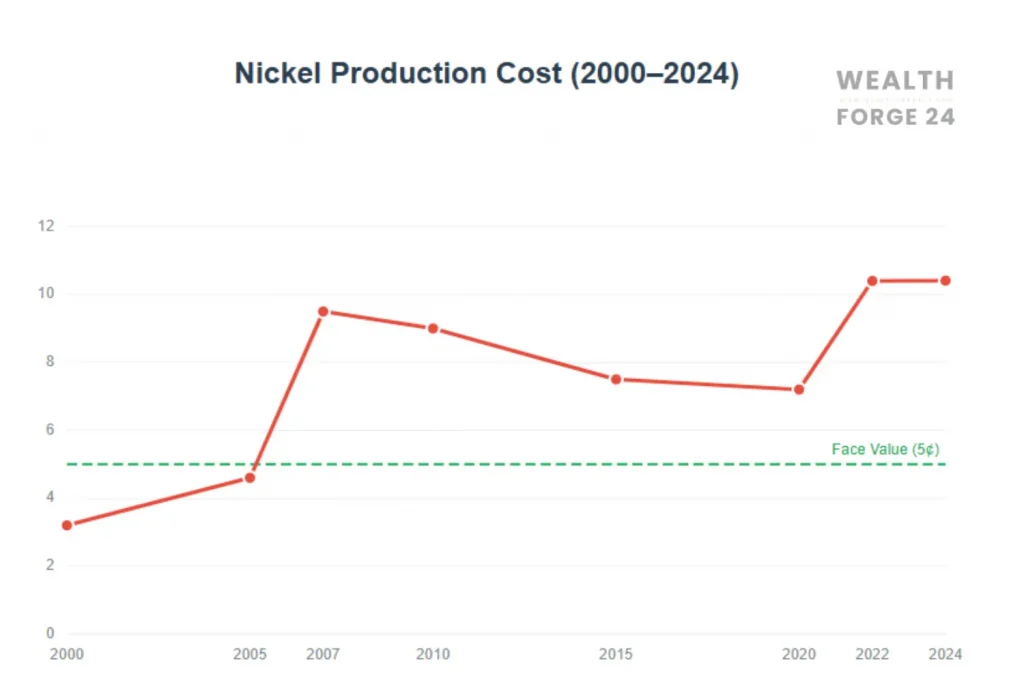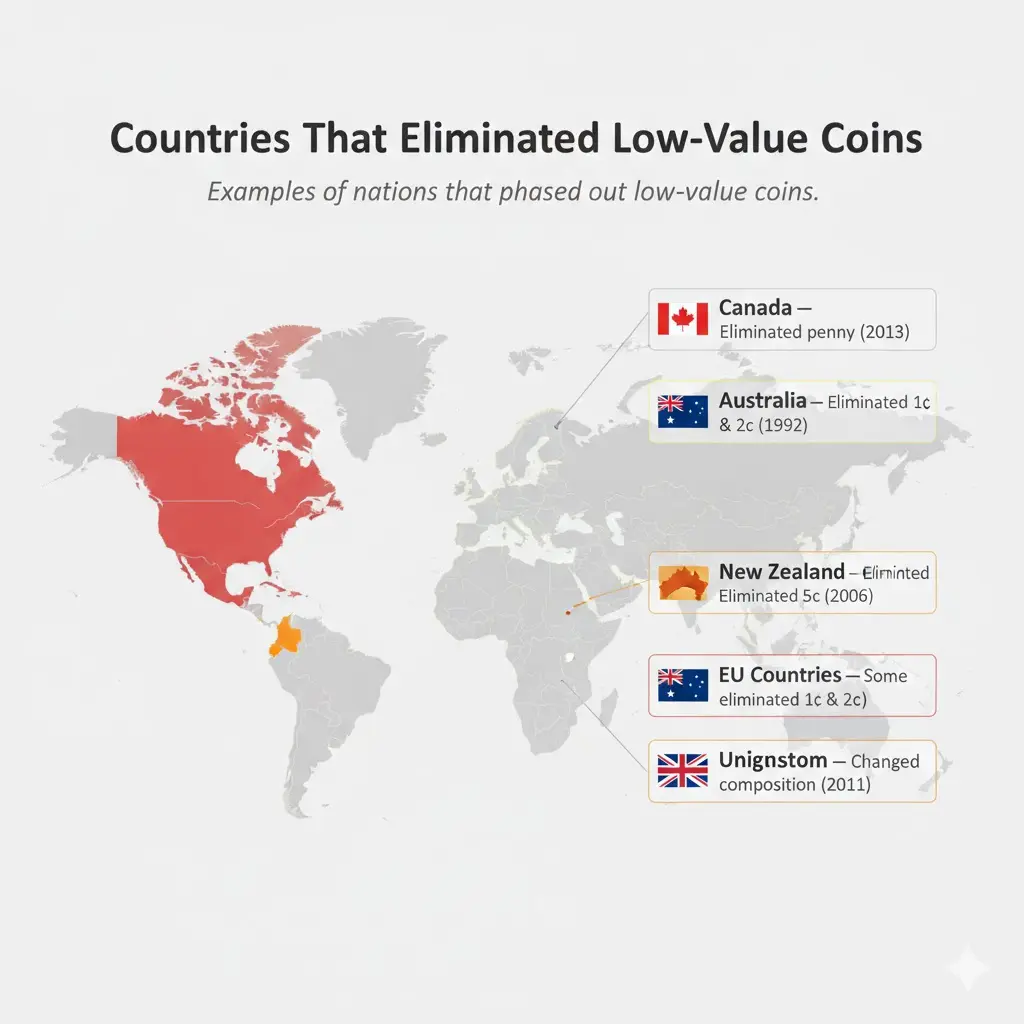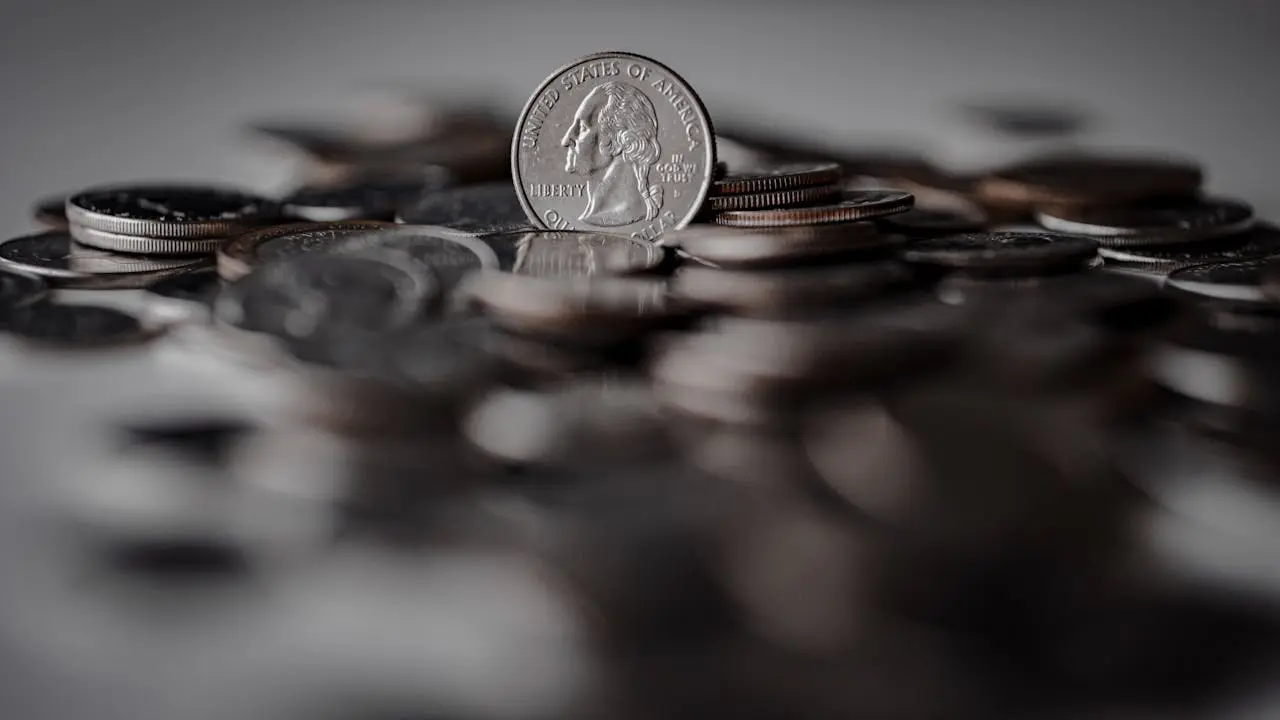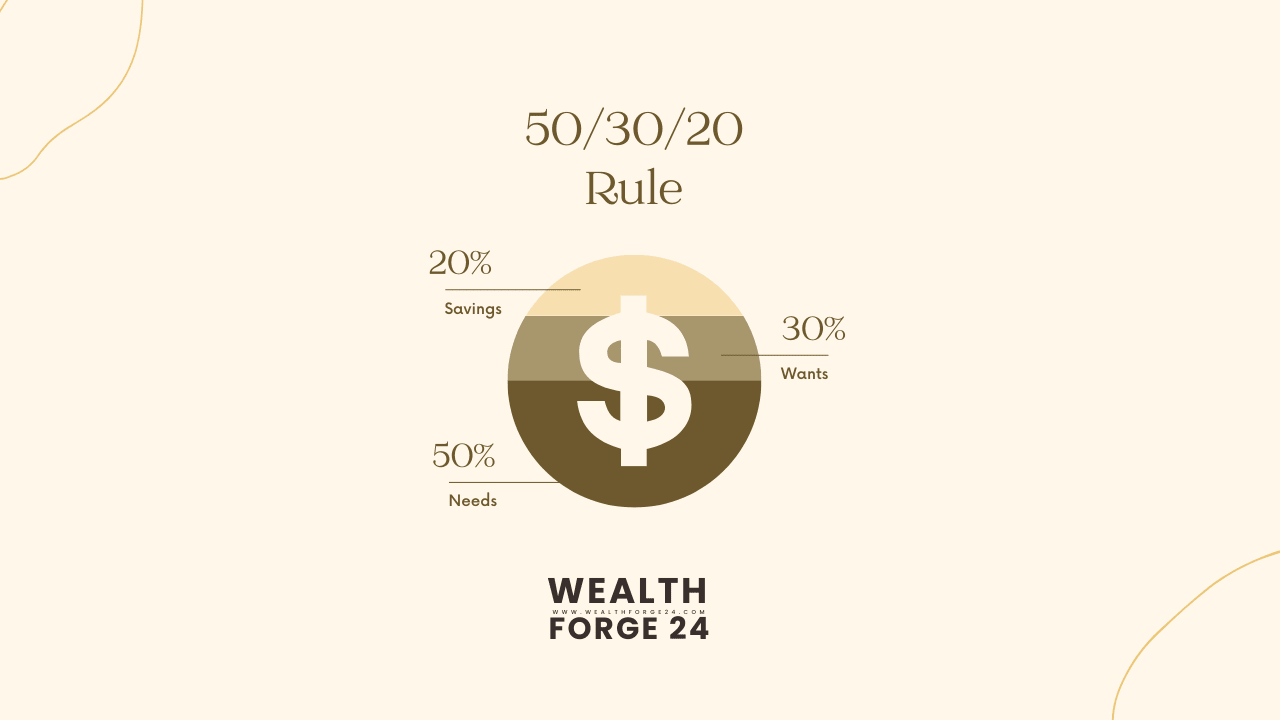The answer could shock you.
Have you ever taken a nickel out of your pocket and wondered how much it really costs? You might be surprised to learn that the US government spends more money making a single nickel than the coin is worth. That’s right—every time the US Mint makes a 5-cent coin, American taxpayers lose money.
In 2024, it cost about 10.41 cents to make each nickel, which is about twice its face value. This indicates that the government loses around 5.41 cents for every nickel it makes. When you compound that by the billions of nickels made each year, the economy loses much money.
But why does this happen? What does this signify for the future of the US dollar? Let’s take a close look at the interesting economics underlying one of the most common coins in the US.
Quick Answer: The Cost of Nickel Production Right Now
The 2024 Numbers
The US Mint’s most recent financial statements show:
- Production cost: 10.41 cents per nickel
- Face value: 5 cents
- Loss per coin: 5.41 cents (108% loss)
- Annual production: About 1.2 billion nickels
- Total annual loss: About $64.9 million
This means that the nickel is the most expensive coin to make in the US compared to its worth. It’s even more costly than the penny, which costs roughly 2.72 cents to make in 2024.
Why This Is Important
You might say, “So what? It’s only a few cents.” But think about this: these losses pile up fast. The US Mint has been losing money on nickels and pennies for years. These losses have added up to hundreds of millions of dollars, which comes from taxpayers in the end.
A Look Back at the Costs of Making Nickel

How We Got Here
The nickel hasn’t always been a bad investment. Let’s take a look at how the expenses of making things have changed:
Early 2000s:
- 2000: around 3.2 cents per nickel
- 2005: About 4.6 cents per nickel
- Still less than face value, but good for the government
The Turning Point (2006–2007):
- 2006: about 5.7 cents per nickel
- 2007: About 9.5 cents per nickel
- The first big losses start
Recent Years:
- 2015: almost 7.5 cents per nickel
- 2020: About 7.2 cents per nickel
- 2022: About 10.4 cents per nickel
- 2024: Around 10.41 cents per nickel
What Changed?
There were many things that led to this big jump:
1. Prices of metals are going up Since 2000, the costs of copper and nickel, the two metals that make up the coin, have gone up a lot. Prices rose because of high demand for certain metals around the world, especially from nations that are quickly becoming industrialised.
2. Costs of Energy Making coins takes much energy. The cost of making things went up as the price of oil and energy went up.
3. Overhead and Labour Inflation has caused wages, building maintenance, and operating costs to go up over the past 20 years.
4. Features for Security Minting methods today have extra quality control and security steps that make them more expensive.
Why Is It So Expensive? Let’s Break Down the Cost
The Makeup of the Material
A nickel from the United States today is made of:
- Copper: About 75%
- Nickel metal: 25%

Since 1866, this copper-nickel alloy (officially named “cupronickel”) has been the usual composition. The only time it changed was during World War II, when nickels were made from 1942 to 1945.
Costs of Raw Materials
Prices of Copper: In 2024, copper is worth about $4.00 to $4.50 per pound in the commodity markets. There are about 3.75 grammes of copper in each nickel, which is worth about 3 to 4 cents per coin.
Prices for Nickel Metal: Nickel metal costs a lot higher, trading at $8 to $9 per pound in 2024. Each coin has roughly 1.25 grammes of nickel metal in it, which adds about 2–3 cents to the cost of the material.
Total cost of raw materials: About 5 to 7 cents per nickel
Costs of Making
In addition to raw materials, there are extra costs that go into production:
1. Blank Production (2–3 cents)
- Mixing and melting metals
- Rolling into sheets
- Punching out empty discs
2. The Process of Minting (1–2 cents)
- Several strike operations
- Check for quality
- Getting ready and packaging
3. Overhead and Distribution (1–2 cents)
- Operations of the facility
- Wages for employees
- Getting to Federal Reserve Banks
- Costs of running a business
The Whole Thing
All in all:
- Raw materials: 5 to 7 cents
- Making things: 2–3 cents
- Overhead and distribution: 1–2 cents
- Total: Around 10 to 11 cents
Looking at the Costs of Different US Coins
| Coin | Image | Production Cost | Face Value | Profit / Loss |
|---|---|---|---|---|
| Penny | 🪙 |
2.72¢ | 1¢ | –1.72¢ ❌ |
| Nickel | 🪙 |
10.41¢ | 5¢ | –5.41¢ ❌ |
| Dime | 🪙 |
4.73¢ | 10¢ | +5.27¢ ✅ |
| Quarter | 🪙 |
11.03¢ | 25¢ | +13.97¢ ✅ |
*Costs represent approximate production/material costs per coin (in cents).*
The nickel isn’t the only one having trouble with its price. Let’s compare it to other denominations:
Costs of Production in 2024
Penny (1 cent)
- Cost of production: 2.72 cents
- Loss per coin: 1.72 cents
- Percentage of loss: 172%
Nickel (5 cents)
- Cost of production: 10.41 cents
- Loss per coin: 5.41 cents
- Loss percentage: 108%
Dime (10 cents)
- Cost of production: 4.73 cents
- Profit per coin: 5.27 cents
- Percentage of profit: 53%
Quarter (25 cents)
- Cost of production: 11.03 cents
- Profit per coin: 13.97 cents
- Profit percentage: 56%
Half Dollar (50 cents)
- Cost of production: 15.52 cents
- Profit per coin: 34.48 cents
- Profit percentage: 69%
One-Dollar Coin
- Cost of making: 16.90 cents
- Profit per coin: 83.10 cents
- Profit margin: 83%
The Money Makers
Notice that dimes and bigger coins make money. This is why:
- They utilise formulations that are cheaper and have copper and nickel in them
- The face values are much higher than the costs of making them
- They benefit from lower costs when they buy in bulk
The government makes money off of these coins, which is termed “seigniorage.” This helps make up for the money it loses on pennies and nickels.
Why Does the Nickel Cost More Than It’s Worth?
The Problem with Metal Prices
The main problem is simple: the metals that go into making a nickel are worth more than the coin itself. This causes a number of issues:
Changes in the Market: The price of metal changes depending on how much of it is available and how much people want it. When the industry needs more copper and nickel (for building, electronics, electric cars, etc.), prices go up, which makes it more expensive to make coins.
Competition Around the World: The US has to compete with other countries and industries for these metals. For example, China’s huge infrastructure investments have a big effect on the price of copper around the world.
The Problem with Composition
You might be wondering, “Why not just change the material of the nickel?” It’s not that easy. This is made harder by a number of things:
1. Compatibility with Vending Machines Millions of vending machines, parking metres, and other automated devices can tell what kind of coins they are by their size, weight, and electromagnetic properties. Changing the composition would mean that thousands of machines across the country would need to be updated or replaced, which would be quite costly.
2. Acceptance by the Public People in the US expect nickels to look, feel, and sound a specific way. People might not like big changes to the composition.
3. Worries About Counterfeiting Any new composition must be hard to copy but still cheap to make.
4. Requirements for Durability Coins need to be able to stay in circulation for decades. Not all combinations of metals are strong enough.
The Small Denomination Challenge
Lower-value coins have built-in economic problems:
Low Face Value: With a value of barely 5 cents, there isn’t much room for production expenditures. Even small costs for materials and manufacturing can be more than the face worth.
Making Many Things: Every year, the US Mint makes billions of nickels. Small loses on each coin add up to huge losses overall.
Effect of Inflation: As inflation makes 5 cents less valuable, the currency gets even less useful as production costs keep going up.
Suggestions for Solutions and Other Options
The government and economists have come up with a few ways to fix the nickel problem:
Option 1: Change the Mix
Nickels Made of Steel: The US may move to steel coins with nickel or copper on top, just like Canada did with its currency. This might bring the price down to about 4 to 5 cents per coin.
Pros:
- Big savings on costs
- Steel is cheaper and more common
Cons:
- Needs to change the way vending machines work
- If the plating is damaged, it could rust
- Different sound and feel
Nickels Made of Aluminium: Aluminium is cheap and light.
Pros:
- The costs of materials are quite inexpensive
- Not prone to rust
Cons:
- Not heavy enough for contemporary vending machines
- People may think it is “cheap”
- Easier to fake
Option 2: Get Rid of the Nickel
Some economists say that we should just cease making nickels.
How It Would Work:
- Round all cash payments to the nearest 10 cents
- Payments made online stay the same
- Nickels that are already in circulation remain there until they wear out
Pros:
- Stop losing money right now
- Makes transactions easier
- A lot of other countries have been able to get rid of low-value coins
Cons:
- People don’t want things to change
- Worries about rounding (even if studies show it balances out)
- Effect on machines that take coins
Examples from the Real World:
- In 2013, Canada got rid of its penny
- Australia and New Zealand don’t make 5-cent coins anymore
- In several parts of Europe, 1 and 2-cent euro coins are no longer used
Option 3: Raise the Face Value
A more extreme idea is to preserve the nickel’s physical qualities but modify its face value to 10 cents.
Pros:
- Profitable right away
- There is no need to change the composition or machines
Cons:
- Never before in US history
- Could make things unclear
- What inflation means
Option 4: Change to Digital Currency
Some people who study the future say that the answer is to stop using cash altogether.
The Future of Technology:
- More people are using credit and debit cards
- Apps for paying on your phone
- Possible central bank digital currencies (CBDCs)
Trends Right Now:
- The number of transactions that use cash has gone down from 31% in 2016 to 18% in 2023
- The COVID-19 pandemic sped up the use of digital payments
- Younger people like to do business online
Problems:
- Not everyone can use digital banking
- Concerns about privacy
- Some groups have trouble using technology
What Professionals Say
From an Economic Point of View
Most economists want to either change the content of the nickel or do without it altogether. The logic is simple: if something keeps losing money, quit doing it or do it differently.
How the Public Feels
Polls demonstrate that people have different opinions:
- 40% want to get rid of the nickel
- 35% want it to stay the same
- 25% want to change the makeup
The Truth About Politics
Things have changed slowly because:
- The group for the zinc and copper industries want to maintain the present coinage
- Some MPs’ constituents don’t want them to change
- “It’s always been this way” manner of thinking
The Economic Effect: How Much Does This Cost the US?
Losses Every Year
Let’s do the math:
Nickel Production (estimates for 2024):
- Coins made: about 1.2 billion
- Loss per coin: $0.0541
- Total loss: about $64.9 million
Penny Production (estimates for 2024):
- Coins made: about 7.4 billion
- Loss per coin: $0.0172
- Total loss: about $127.3 million
Total Loss for the Year: About $192.2 million
Costs in the Long Run
The total losses from making nickels and pennies over the past ten years (2014–2024) are more than $1.5 billion. That money may have been spent on:
- Better infrastructure
- Programmes for education
- Health care services
- Lessening of debt
Who Pays?
In the end, American taxpayers pay for these things. The US Mint is part of the Department of the Treasury, and the money it loses comes from taxes that everyone pays.
The Bigger Picture
In the grand scheme of things, $192 million a year isn’t a lot when you consider that the federal budget is roughly $6.1 trillion in 2024. It makes up about 0.003% of what the federal government spends.
But the principle is important. John McCain, a former senator, remarked, “If we can’t make a decision on something that is so obvious, it makes us wonder if we can make the tough decisions on bigger issues.”

International Viewpoint: How Other Countries Deal with This
Countries That Got Rid of Coins That Aren’t Worth Much
Canada:
- Took away the penny in 2013
- Reported savings of $11 million every year
- The public adjustment went more smoothly than predicted
- Cash transactions round to the nearest five cents
Australia:
- In 1992, they stopped making 1- and 2-cent coins
- Successfully transitioned with minimal disruption
- The rounding system works great
New Zealand:
- No more 5-cent coins since 2006
- Then, in 2006, they took out 10-cent coins
- The smallest coin is now 10 cents
The European Union:
- Some countries, like the Netherlands, Finland, and Ireland, don’t utilise 1 and 2 cent euros
- Rounding off transactions
- Euro coins are the same everywhere, but each country decides how to make them differently
Countries That Changed Their Compositions
UK:
- Changed to coins made of steel in 2011
- The costs of production went down a lot
- People hardly noticed the change
Japan:
- The 1 yen coin is made of aluminium
- It is still in circulation even though it is worth less than 1 US penny
- Costs of production are low
Things I Learned
What can the US learn from these cases?
- Change is manageable: People are generally more scared about losing their jobs or having their jobs changed than they are of actually having their jobs changed
- Genuine savings: Countries that made modifications say they saw genuine savings in their finances
- Technology helps: New payment systems make it easier to switch than in the past
- Timing is important: Big changes in currency are best when the economy is stable

The Nickel’s Future
Outlook for the Short Term (2025–2030)
In the near future, you can expect:
Continuing the Status Quo:
- Even if they are losing money, the US Mint will probably keep making nickels
- Political deadlock might stop big changes from happening
- Losses will keep piling up
Possible Composition Studies:
- Congress might let studies on other materials happen
- Pilot programmes could try out novel compositions
- We will get comments from the public
Possible Things That Could Happen in the Next 10 to 20 Years (2030–2040)
Looking ahead even more:
Most Likely Change in Composition:
- Nickels made of steel are probably the answer
- Updates for vending machines will be easier and cheaper thanks to technology
- You could save 50–60% on costs
Possible Gradual Phase-Out:
- Demand for real coins will go down as digital payments become more popular
- There may be a natural phase-out without an official end
- It may be like the $2 bill: legal but not seen very often
The Future in the Long Term (2040+)
The Debate About a Cashless Society:
- Some experts think that cash will no longer be useful
- Some people say that currency will always have a place
- The truth is probably somewhere in the middle
Digital Currencies from Central Banks:
- The Federal Reserve is looking into a digital dollar
- CBDCs might make it less necessary or even unnecessary to use real currency
- Concerns of privacy and access need to be dealt with
Things to Think About for the Environment:
- Mining metals harms the ecosystem
- Digital currency is more sustainable, but it does have its own energy problems
- The impact on the environment may be more important to future generations
What This Means for You
What It Means in Real Life
Should You Save a Lot of Nickels?
You might wonder if nickels are like pre-1982 pennies, which some people collect because they are made of copper. This is the truth:
- You can’t melt down US coins to get the metal out of them
- The procedure isn’t cost-effective for individuals, even if it were
- The metal value of a nickel (~7-8 cents) doesn’t justify hoarding
- Storage and transaction costs would eliminate any theoretical profit
Impact on Everyday Life:
For most Americans, changes to the nickel would have minimal impact:
- Rounding to the closest 10 cents only affects cash transactions
- Digital payments are unaffected
- Any transition would be gradual
Investment Perspective:
The nickel situation illustrates broader economic principles:
- Government inefficiencies exist at all levels
- Sunk cost fallacy (continuing something because “we’ve always done it”)
- Political challenges of making logical but unpopular decisions
Frequently Asked Questions
Why doesn’t the US Mint just use cheaper metals?
The main obstacle is compatibility with existing vending machines and coin-operated devices. Millions of machines across America detect coins by their specific weight and electromagnetic properties. Changing the nickel’s composition would require updating or replacing these machines, which is expensive and logistically complex. However, as technology improves and machines are replaced naturally, this becomes more feasible.
Has the nickel always cost more to make than it’s worth?
No. For most of nickel’s history, it cost less than 5 cents to produce. The problem really began in 2006-2007 when rising metal prices pushed production costs above face value. Before the 2000s, nickel was profitable for the government to produce.
What happens to old nickels when they wear out?
Worn or damaged nickels are removed from circulation by banks and sent back to the Federal Reserve. They’re then transferred to the US Mint for recycling. The metals are recovered and can be reused in new coin production, which helps offset some costs.
Could we make nickels smaller to save money?
While making nickels smaller would reduce material costs, it creates several problems: vending machine incompatibility, public confusion, and counterfeiting concerns. Any size change would essentially require the same adjustments as a composition change, so there’s little advantage to this approach.
Do other countries have the same problem with their coins?
Many countries face similar issues with low-denomination coins. However, many have been more proactive in addressing the problem by eliminating these coins or changing their composition. The US has been slower to make changes, partly due to political considerations and the massive scale of America’s cash economy.
How much does it cost to make other coins like quarters or dimes?
Interestingly, dimes and quarters are profitable to produce. A dime costs about 4.73 cents to make (profit of 5.27 cents), and a quarter costs about 11.03 cents (profit of 13.97 cents). These profits help offset losses from pennies and nickels, but don’t completely eliminate them.
Will nickels become valuable as collectibles if they’re eliminated?
While some newly eliminated currency gains modest collectible value, common nickels likely won’t become significantly valuable. Billions of nickels are in circulation, making them far from rare. Special editions, mint errors, or historically significant nickels might have value, but regular circulation nickels would remain common.
What would happen if metal prices dropped significantly?
If copper and nickel prices fell substantially (which is unlikely given long-term demand trends), production costs would decrease. However, even a 30-40% drop in metal prices would only bring production costs close to face value, not significantly below it. The structural issue would remain.
The Bottom Line: A Small Coin, Big Implications
The nickel’s production cost problem is more than just a curiosity – it’s a window into larger economic and political challenges facing America.
Key Takeaways
The Numbers Don’t Lie:
- Producing a nickel costs 10.41 cents in 2024
- The government loses 5.41 cents on every nickel made
- Annual losses exceed $64 million just for nickels
- Combined with pennies, total losses approach $200 million yearly
The Problem Is Solvable:
Multiple solutions exist:
- Change the composition to cheaper metals
- Eliminate the nickel and round to 10 cents
- Accelerate the transition to digital payments
- Some combination of the above
Change Is Difficult:
Despite clear economic logic, actual change faces obstacles:
- Vending machine industry concerns
- Public resistance to change
- Political gridlock
- “We’ve always done it this way” mentality
What Should Happen?
From a purely economic standpoint, the US should either:
- Change the nickel’s composition to reduce costs below face value, or
- Eliminate it entirely and round cash transactions
The longer we wait, the more money we waste. Yet pragmatically, change may come slowly through:
- Natural decline in cash usage
- Gradual technological updates
- Shifting public opinion
- New generations are less attached to traditional currency
A Broader Lesson
The nickel situation teaches us something important about economics and policy: sometimes the logical choice isn’t the easy choice. Sometimes inefficiencies persist not because we don’t know how to fix them, but because change is hard.
As digital payments continue to grow and physical currency becomes less central to daily transactions, the nickel problem may solve itself. But until then, every time you use a nickel, remember: that small coin represents a surprisingly complex intersection of economics, politics, technology, and tradition.
Sources and Further Reading
- U.S. Mint Annual Financial Reports (2020-2024)
- Federal Reserve Statistical Releases
- Congressional Research Service Reports on Coin Production
- Bureau of Labor Statistics – Metal Price Data
- Academic studies on currency elimination in other countries








